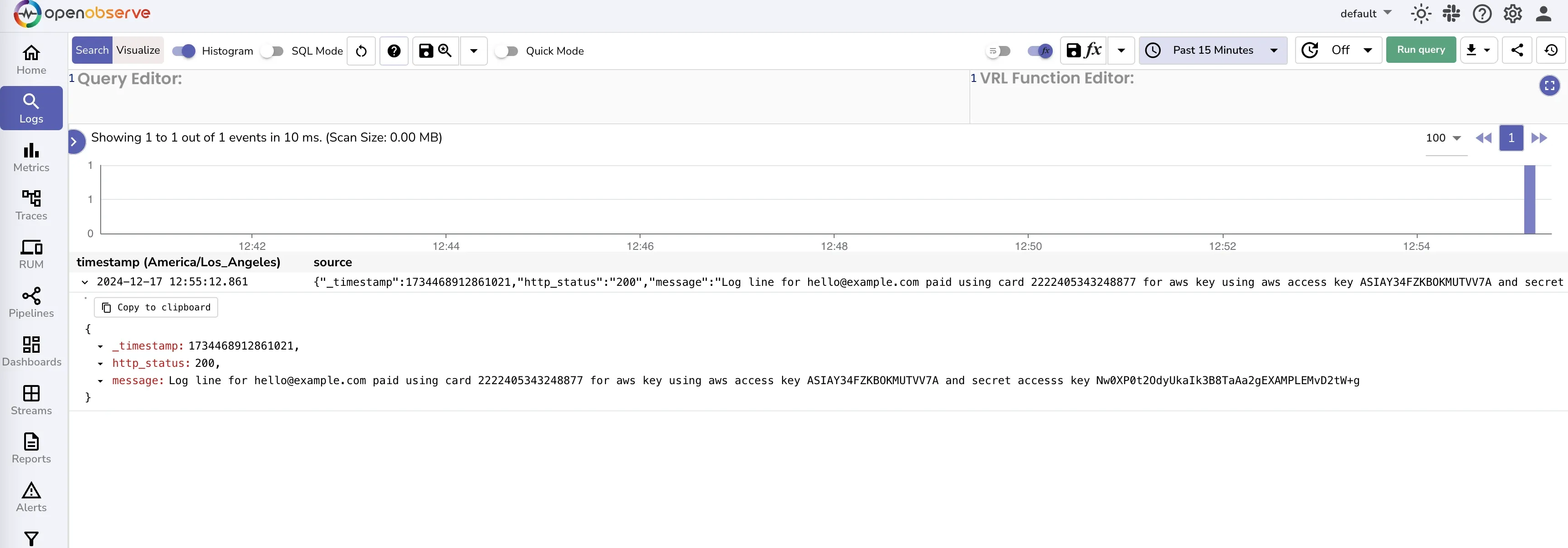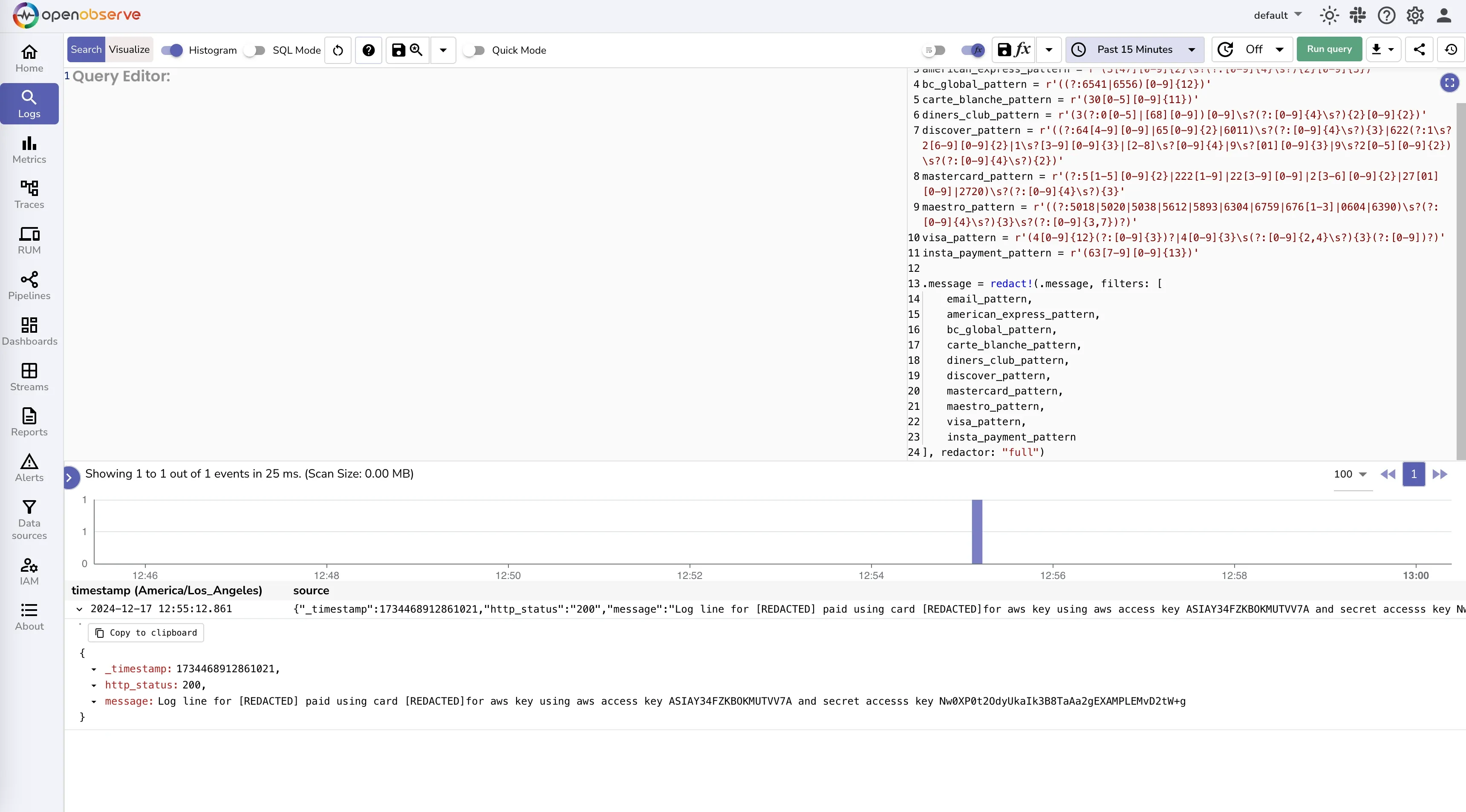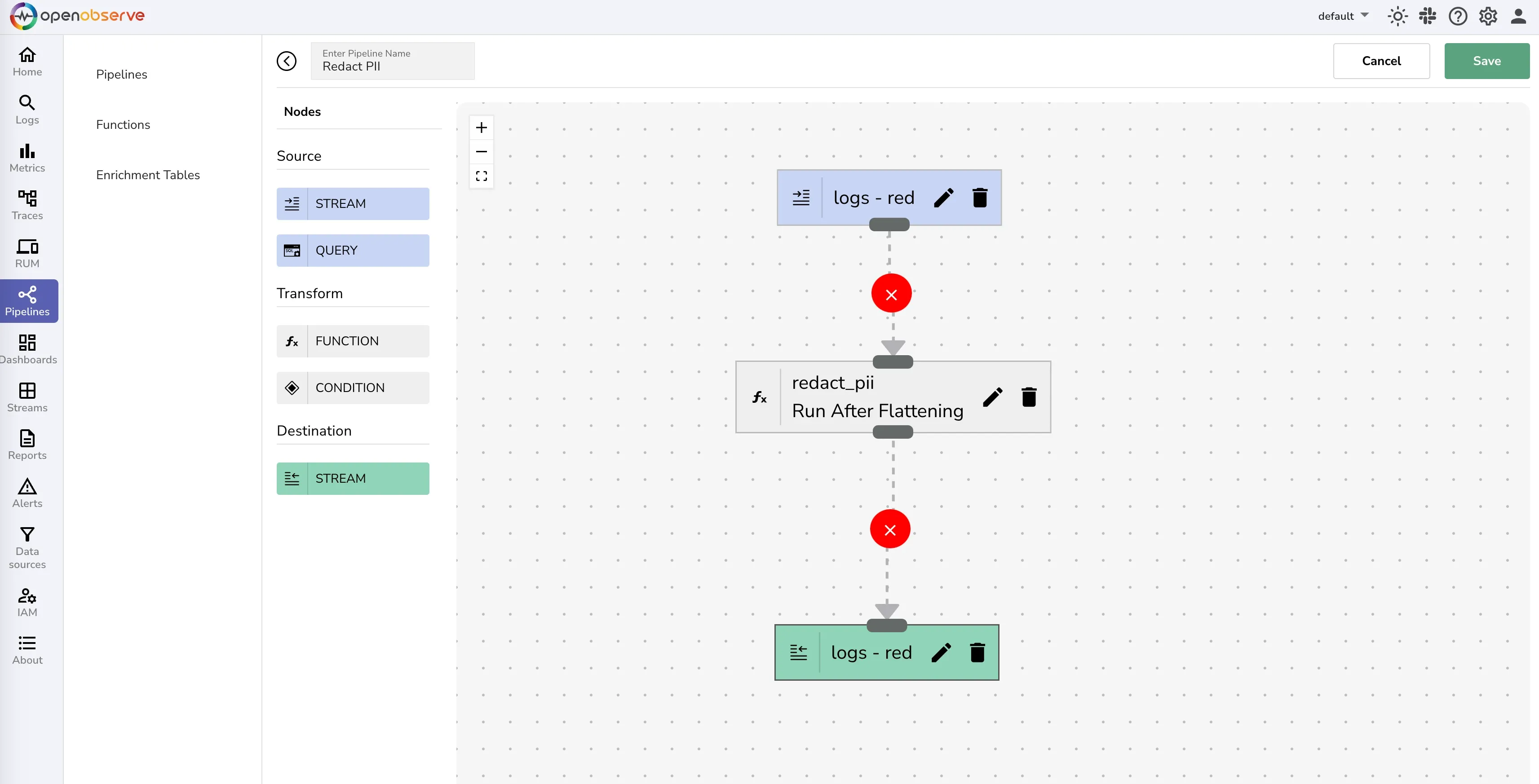How to redact sensitive / PII data in your logs



As you collect and store increasingly large amounts of log data, the risk of sensitive information being exposed grows. Sensitive data, such as email addresses, credit card numbers, and API keys, can be inadvertently logged, posing a significant security risk. Redacting sensitive data from logs is crucial to protect user privacy and prevent data breaches.
In this blog, we'll explore the importance of redacting sensitive data from logs and provide examples of how to do so using Vector Remap Language (VRL). We'll cover redacting email addresses, credit card numbers, and AWS keys. You will be able to do it for other scenarios as well from what you learn here.
Logging sensitive data can have severe consequences, including:
Vector VRL is a powerful language for processing and transforming log data. It's redact function allows you to remove sensitive data from logs.
Syntax of the redact function is:
redact(value: <string | object | array> , filters: <array> , [redactor: <string | object> ])
:: <string | object | array>
value can be either string, object or an array.
In order to redact a single field you can use:
email_pattern = r'\b[A-Za-z0-9._%+-]+@[A-Za-z0-9.-]+\.[A-Z|a-z]{2,}\b'
.message = redact!(.message, filters: [ email_pattern ], redactor: "full")
In order to configure you the whole record you can use:
email_pattern = r'\b[A-Za-z0-9._%+-]+@[A-Za-z0-9.-]+\.[A-Z|a-z]{2,}\b'
. = redact(., filters: [ email_pattern ], redactor: "full")
Doing this for the whole record as opposed to a single field, would require more compute during ingestion. Hence plan accordingly.
Let's take an example log record:
{
"message": "Log line for hello@example.com paid using card 2222405343248877 for aws key using aws access key ASIAY34FZKBOKMUTVV7A and secret accesss key Nw0XP0t2OdyUkaIk3B8TaAa2gEXAMPLEMvD2tW+g",
"http_status": "200"
}
You can ingest this data in your environment using:
curl --request POST -u "root@example.com:Complexpass#123" \
--url http://localhost:5080/api/default/default/_json \
--header 'content-type: application/json' \
--data '[
{
"message": "Log line for hello@example.com paid using card 2222405343248877 for aws key using aws access key ASIAY34FZKBOKMUTVV7A and secret accesss key Nw0XP0t2OdyUkaIk3B8TaAa2gEXAMPLEMvD2tW+g",
"http_status": "200"
}
]'
Make sure to replace the credentials

To redact email addresse, you can use the following VRL script:
email_pattern = r'\b[A-Za-z0-9._%+-]+@[A-Za-z0-9.-]+\.[A-Z|a-z]{2,}\b'
.message = redact!(.message, filters: [
email_pattern
], redactor: "full")
This script uses a regular expression to match email addresses in the message field and replaces them with [REDACTED].
You should see below.

To redact credit card numbers,you must understand that there are various credit card number formats. We have collected various credit card number formats that you can use:
email_pattern = r'\b[A-Za-z0-9._%+-]+@[A-Za-z0-9.-]+\.[A-Z|a-z]{2,}\b'
american_express_pattern = r'(3[47][0-9]{2}\s?(?:[0-9]{4}\s?){2}[0-9]{3})'
bc_global_pattern = r'((?:6541|6556)[0-9]{12})'
carte_blanche_pattern = r'(30[0-5][0-9]{11})'
diners_club_pattern = r'(3(?:0[0-5]|[68][0-9])[0-9]\s?(?:[0-9]{4}\s?){2}[0-9]{2})'
discover_pattern = r'((?:64[4-9][0-9]|65[0-9]{2}|6011)\s?(?:[0-9]{4}\s?){3}|622(?:1\s?2[6-9][0-9]{2}|1\s?[3-9][0-9]{3}|[2-8]\s?[0-9]{4}|9\s?[01][0-9]{3}|9\s?2[0-5][0-9]{2})\s?(?:[0-9]{4}\s?){2})'
mastercard_pattern = r'(?:5[1-5][0-9]{2}|222[1-9]|22[3-9][0-9]|2[3-6][0-9]{2}|27[01][0-9]|2720)\s?(?:[0-9]{4}\s?){3}'
maestro_pattern = r'((?:5018|5020|5038|5612|5893|6304|6759|676[1-3]|0604|6390)\s?(?:[0-9]{4}\s?){3}\s?(?:[0-9]{3,7})?)'
visa_pattern = r'(4[0-9]{12}(?:[0-9]{3})?|4[0-9]{3}\s(?:[0-9]{2,4}\s?){3}(?:[0-9])?)'
insta_payment_pattern = r'(63[7-9][0-9]{13})'
.message = redact!(.message, filters: [
email_pattern,
american_express_pattern,
bc_global_pattern,
carte_blanche_pattern,
diners_club_pattern,
discover_pattern,
mastercard_pattern,
maestro_pattern,
visa_pattern,
insta_payment_pattern
], redactor: "full")
This script uses regular expressions to match credit card numbers in the message field and replaces them with [REDACTED].
Now you have both email and credit card redacted.

To redact AWS keys, you can use the following VRL script:
aws_access_key_pattern = r'(?:^|[^A-Z0-9])[A-Z0-9]{20}(?:[^A-Z0-9]|$)'
aws_secret_key_pattern = r'(?:^|[^A-Za-z0-9/+=])[A-Za-z0-9/+=]{40}(?:[^A-Za-z0-9/+=]|$)'
email_pattern = r'\b[A-Za-z0-9._%+-]+@[A-Za-z0-9.-]+\.[A-Z|a-z]{2,}\b'
american_express_pattern = r'(3[47][0-9]{2}\s?(?:[0-9]{4}\s?){2}[0-9]{3})'
bc_global_pattern = r'((?:6541|6556)[0-9]{12})'
carte_blanche_pattern = r'(30[0-5][0-9]{11})'
diners_club_pattern = r'(3(?:0[0-5]|[68][0-9])[0-9]\s?(?:[0-9]{4}\s?){2}[0-9]{2})'
discover_pattern = r'((?:64[4-9][0-9]|65[0-9]{2}|6011)\s?(?:[0-9]{4}\s?){3}|622(?:1\s?2[6-9][0-9]{2}|1\s?[3-9][0-9]{3}|[2-8]\s?[0-9]{4}|9\s?[01][0-9]{3}|9\s?2[0-5][0-9]{2})\s?(?:[0-9]{4}\s?){2})'
mastercard_pattern = r'(?:5[1-5][0-9]{2}|222[1-9]|22[3-9][0-9]|2[3-6][0-9]{2}|27[01][0-9]|2720)\s?(?:[0-9]{4}\s?){3}'
maestro_pattern = r'((?:5018|5020|5038|5612|5893|6304|6759|676[1-3]|0604|6390)\s?(?:[0-9]{4}\s?){3}\s?(?:[0-9]{3,7})?)'
visa_pattern = r'(4[0-9]{12}(?:[0-9]{3})?|4[0-9]{3}\s(?:[0-9]{2,4}\s?){3}(?:[0-9])?)'
insta_payment_pattern = r'(63[7-9][0-9]{13})'
.message = redact!(.message, filters: [
aws_access_key_pattern,
aws_secret_key_pattern,
email_pattern,
american_express_pattern,
bc_global_pattern,
carte_blanche_pattern,
diners_club_pattern,
discover_pattern,
mastercard_pattern,
maestro_pattern,
visa_pattern,
insta_payment_pattern
], redactor: "full")
This script uses a regular expression to match AWS keys in the message field and replaces them with [REDACTED].

Now that you have been able to test the function that works well, let's build a pipeline.

This will now redact any sensitive or PII data before your log data is ingested and stored.
When redacting sensitive data, keep the following best practices in mind:
Check the open source pyWhat project at https://github.com/bee-san/pyWhat/tree/main/pywhat/Data
Redacting sensitive data from logs is essential to protect user privacy and prevent data breaches. By using Vector VRL and following best practices, you can effectively remove sensitive data from your logs and ensure compliance with regulations. Remember to regularly review and update your redaction scripts to stay ahead of evolving security threats.

Prabhat Sharma is the founder of OpenObserve, bringing extensive expertise in cloud computing, Kubernetes, and observability. His interests also encompass machine learning, liberal arts, economics, and systems architecture. Outside of work, Prabhat enjoys spending quality time playing with his children.